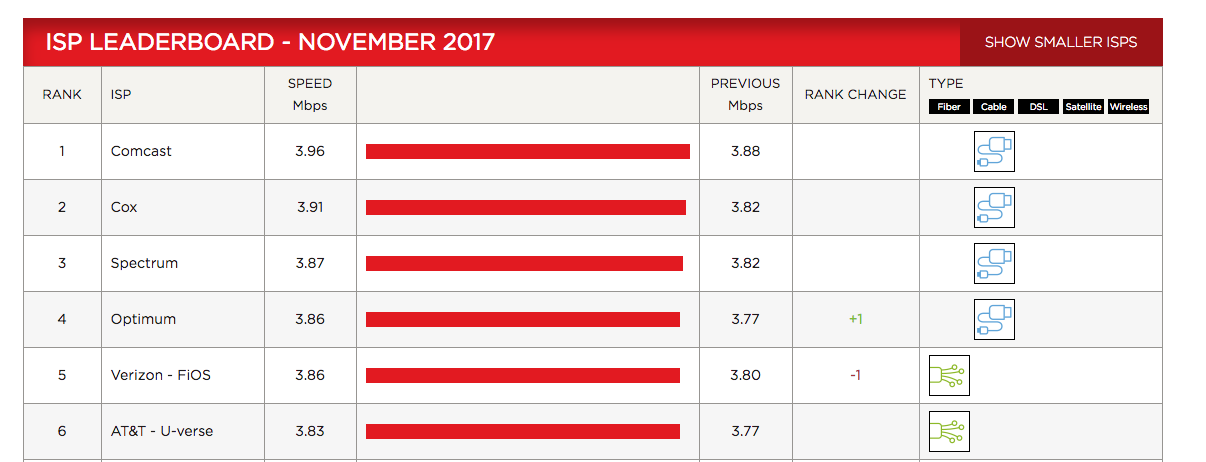1. The FCC’s plan to repeal the 2015 Open Internet Order and net neutrality will be stalled in court, and consumers will watch cable and telecom companies like hawks

Telecom and cable companies will force OTT and internet video streaming companies, like Netflix, Hulu, and Amazon, into a battle on two fronts. On one side, Ajit Pai will likely pursue repealing net-neutrality on Thursday despite outcries to the contrary.. On the other, they’ll create their own direct-to-consumer streaming services that will compete for the attention of cord-cutter and cord-nevers.
But various industry and political groups will attempt to stall his plan. New York Attorney General, Eric Schneiderman, already sent an open letter to Pai and the FCC, urging them to slow the repeal process to consider, at the very least, the bizarre results in the FCC’s public comments, citing the stolen identities of at least 10,000 New Yorkers.
Ultimately, I think the US Court of Appeals, or maybe even the Supreme Court, will settle this highly contentious battle and dampen the apparent rapidity of net neutrality’s dissolution.
No matter how it pans out, consumers and industry will watch telecom and cable companies very closely. Netflix CEO, Reed Hastings, already told reporters, “The culture around net neutrality is very strong. The expectations of consumers are very strong So even if the formal framework gets weakened, we don’t see a big risk actualizing, because consumers know they’re entitled to all of the web services.”
Learn how sports media can balance platforms as it transitions to DTC.
2. Sports will drive traditional broadcasters to adopt internet video streaming

CBS Sports, NBC Sports, Disney and ESPN (through BAMTech Media) are all creating internet video streaming platforms for live sports. And there are great opportunities to stream several international competitions this year: FIFA World Cup, The Commonwealth Games (The Friendlies), and the Winter Olympics. NBC Olympics, for example, will live stream 1,800 hours of its NBC’s record-breaking 2,400+ hours of coverage. These multi-sport international competitions are perfect for OTT because:
- There are so many concurrent events that only OTT or direct-to-consumer streaming could offer the viewer the choice between all the events
- Differences in time-zone also mean that viewers can watch matches or events on their phone, tablet, or laptop at their own convenience
- OTT means that any fan can watch any team any where.
Daniel Alarcón summarized it eloquently in a recent article, “Away Games,” in The New Yorker:
“This is how we experience the world’s most popular sport [soccer or football] today. Watching a game with Twitter is like watching in a crowded bar. Watching with WhatsApp is like watching in someone’s living room. Watching with both is a kind of meditation, a sense of being in many places at once–or, more to the point, in some other realm altogether, outside time and geography, connected to an event but floating above it, near it, holding hands with strangers and loved ones who are doing the same thing.”
3. Traditional broadcasters are hedging their bets, setting up their video streaming to scale but still letting TV drive revenue. It won’t be enough in 2018.
Traditional broadcasters who launch streaming TV will be watching 2018 closely, while building their capability to scale live video streaming services when the time is right.
Walt Disney Co. and 21st Century Fox are closing a deal in which Disney would purchase several Fox assets, including 5,500 live-events associated with Regional Sports Networks.
Comcast launched its Xfinity Instant TV, bundling many free TV channels into an $18 package and offering additional channel packs for a higher price. Perhaps curiously, Comcast will deliver Instant TV over its own networks (rather than OTT), probably anticipating a repeal of net neutrality and the possibility that they could sell rights to stream on their network.
While Disney announced that it’s new growth strategy will be direct-to-consumer streaming, they’re not offering anything on the future ESPN service that already airs on TV.
The equation is quite simple, really, because so much live content goes un-broadcasted. This is the great strength of internet video streaming libraries. So rather than transition TV content to OTT, traditional broadcasters are, first, driving audience growth by making available on OTT streaming all the content that’s unavailable on linear TV.
4. There will be significant investment in OTT and direct-to-consumer video streaming platforms to engage audiences
As competition between traditional broadcasters and OTT becomes fiercer, both will look to create richer and more engaging streaming ecosystems for their viewers. We’ve already written an article on how to engage viewers through direct-to-consumer live sports but it’s worth repeating here: the more crowded the streaming space gets, the more likely that businesses will need to innovate ways to engage their users. This includes software for AR and VR, but also software for bringing human interaction into the digital age, e.g. live interaction between audiences and broadcasters with live chat.

The rise of APIs drive this innovation. An API is a programmable module that allows your software to integrate with other highly specialized functions, like chat or OTT broadcasting and syndication. So you can get your OTT streaming from Brightcove, Ooyala, Akamai and your live chat from SendBird or Twilio.
5. There will be intense competition for creating original content, causing industry giants to acquire content through any means possible
Walt Disney Co. already bought a majority stake in BAMTech Media. Apple and Facebook will each spend about $1 billion on original content. Google has signalled that it would spend $3 billion for a scripted drama for YouTube. Comcast acquired NBCUniversal. AT&T is attempting to acquire Time Warner, though the Department of Justice is considering an antitrust suit against the deal.
Although I feel sure that there’s no end to the world’s appetite for binge-watching video content, the race for original content will become more intense. “This year, there are expected to be more than 500 scripted TV shows,” the New York Times reported, “more than double the number six years ago.”



